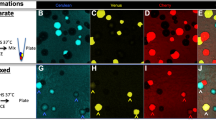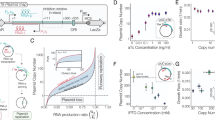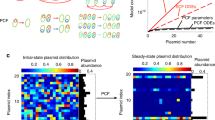Abstract
To restrict horizontal gene spread and, thus, create organisms whose behavior in the field is more predictable, we have combined a mini-Tn5 cloning system that allows stable insertion of foreign genes into the chromosomes of a variety of Gram-negative bacteria with a gene-containment circuit based on the universal lethal-function colicin E3. Use of the system is exemplified by the construction of a microorganism designed to degrade polychlorinated biphenyls, important environmental pollutants. The relevant genotype of the microorganism is subject to a stringent gene-containment mechanism that provides neither an advantage nor a disadvantage to the host cell for survival, but decreases frequencies of productive chromosomal transfer frequencies by at least four orders of magnitude.
This is a preview of subscription content, access via your institution
Access options
Subscribe to this journal
Receive 12 print issues and online access
$209.00 per year
only $17.42 per issue
Buy this article
- Purchase on Springer Link
- Instant access to full article PDF
Prices may be subject to local taxes which are calculated during checkout
Similar content being viewed by others
References
Ramos, J.L., Andersson, P., Jensen, L.B., Ramos, C., Ronchel, M.C., Díaz, E., Timmis, K.N. and Molin, S. 1995. Suicide microbes on the loose. Bio/Technology 13: 35–37.
Wilson, M. and Lindow, S.E. 1993. Release of recombinant microorganisms. Annu. Rev. Microbiol. 47: 913–944.
Veal, D.A., Stokes, H.W. and Daggard, G. 1992. Genetic exchange in natural microbial communities. Advances in Microbial Ecology 12: 383–340.
Herrero, M., de Lorenzo, V. and Timmis, K.N. 1990. Transposon vectors containing non-antibiotic resistance selection markers for cloning and stable chromosomal insertion of foreign genes in Gram-negative bacteria. J. Bacteriol. 172: 6557–6567.
de Lorenzo, V. and Timmis, K.N. 1994. Analysis and construction of stable phe-notypes in Gram-negative bacteria with Tn5 and Tn70-derived mini-transposons. Methods Enzymol. 235: 386–405.
Ramos, J.L., Dáaz, E., Dowling, D., de Lorenzo, V., Molin, S., O'Gara, F., Ramos, C. and Timmis, K.N. 1994. The behavior of bacteria designed for biodegradation. Bio/Technology 12: 1349–1356.
Ramos-González, M.-L., Ramos-Dáaz, M.-A. and Ramos, J.L. 1994. Chromosomal gene capture mediated by the Pseudomonas putidaTOL catabolic plasmid. J. Bacteriol. 176: 4635–1641.
Lorenz, M.G. and Wackernagel, W. 1994. Bacterial gene transfer by natural genetic transformation in the environment. Microbiol. Rev. 58: 563–602.
Díaz, E., Munthali, M., de Lorenzo, V. and Timmis, K.N. 1994. Universal barrier to lateral spread of specific genes among microorganisms. Mol. Microbiol. 13: 855–861.
Masaki, H. and Ohta, T. 1985. Colicin E3 and its immunity genes. J. Mol. Biol. 182: 217–227.
Dowling, D.N., Pipke, R. and Dwyer, D.F. 1993. A DNA module encoding bphgenes for the degradation of polychlorinated biphenyls (PCBs). FEMS Microbiol. Lett. 113: 149–154.
Hofer, B., Backhaus, S. and Timmis, K.N. 1994. The biphenyl/polychlorinated biphenyl-degradation locus (bph)of Pseudomonassp. LB400 encodes four additional metabolic enzymes. Gene 144: 9–16.
Assinder, S.J. and Williams, P.A. 1990. The TOL plasmids: determinants of the catabolism of toluene and the xylenes. Advances in Microbial Physiology 31: 1–69.
Simon, R., Quandt, J. and Klipp, W. 1989. New derivatives of transposon Tn5 suitable for mobilization of replicons, generation of operon fusions and induction of genes in Gram-negative bacteria. Gene 80: 161–169.
Sambrook, J., Fritsch, E.F. and Maniatis, T., 1989. Cloning: A Laboratory Manual, 2nd Ed. Cold Spring Harbor Laboratory. Cold Spring Harbor, New York.
Author information
Authors and Affiliations
Rights and permissions
About this article
Cite this article
Munthali, M., Timmis, K. & Díaz, E. Restricting the Dispersal of Recombinant DNA: Design of a Contained Biological Catalyst. Nat Biotechnol 14, 189–191 (1996). https://doi.org/10.1038/nbt0296-189
Received:
Accepted:
Issue Date:
DOI: https://doi.org/10.1038/nbt0296-189



